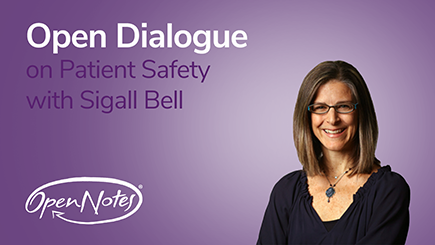
We sat down with Sigall Bell, MD, associate professor of medicine at Harvard Medical School, to learn why she thinks sharing notes with patients is a critical safety intervention. Dr. Bell leads the OpenNotes Patient Safety Initiative, a multi-site study examining relationships among OpenNotes and safety outcomes.
How did you get involved with OpenNotes?
Moving to OpenNotes was a natural segue from my earlier work on medical error disclosure. We shouldn’t just be reactive and work to communicate transparently with patients and families after something’s gone wrong. Instead, let’s ask how we can embrace transparency before things go wrong, to strengthen patient-clinician partnerships and safety, and try to ensure that things go as ‘right’ as possible.
Why is OpenNotes important for patient safety?
While leading healthcare organizations and patient safety experts urge patient engagement as a key component of patient safety, proven ways to engage patients effectively in their care as safety and diagnostic partners are few. OpenNotes is a relatively simple, rapidly scalable solution that can quickly put legs under the idea of engaging patients in their care and in their safety.
Can you give specific examples of how OpenNotes affects patient safety?
There are many ways that OpenNotes can improve patient safety. For example, patients and families report that reading notes helps them understand and complete next steps, such as having tests and following through on referrals, key priorities in ambulatory risk and diagnostic excellence. It also helps care partners supporting vulnerable patients to stay informed, and thereby it may help avoid medication errors, diagnostic delay, or preventable readmissions. Patients and family members are able to identify meaningful documentation errors in their notes, adding to a growing literature demonstrating that patients and families are capable safety partners.
In addition to medication errors and inaccurate medical histories, patients report serious errors involving diagnosis, sidedness errors (such as the wrong eye listed prior to surgery), and many other examples. We are also finding that sharing notes with patients and care partners can strengthen trust, teamwork, goal alignment and activation. These attributes help build stronger safety partnerships.
What’s next for OpenNotes and patient safety?
Diagnostic excellence is now a national priority. I think sharing notes with patients and families is a strong first step toward engaging patients in diagnostic accuracy. Sharing notes provides a tangible way to give patients a defined role in collaborative safety efforts. Without access to notes, patients and families have few, if any, ways to ensure that the doctor heard their report of symptoms accurately. They may have a much harder time remembering all that was discussed in the office, including diagnostic tests or procedures the doctor recommends. Keeping patients and doctors connected in the space between visits, where many ambulatory diagnostic errors occur, may prove critical.
We’re also thinking about ways that patients and families can participate in accurate diagnoses through “OurNotes” – or co-generation of notes. Does the presence of the patient’s own words in the note help stem cognitive errors such as “diagnostic anchoring” due to clinician bias? For example, time-pressed clinicians may make cognitive errors in what they hear, interpret, or remember from patients’ stories. They may draw premature conclusions based on their own experience of the visit and then remain fixated on that diagnostic pathway. Seeing the symptoms described in the patient’s own words may help focus clinicians on the patient’s experience and primary concerns, thereby reducing cognitive biases arising from early and potentially erroneous impressions.
Will patients be more likely to follow up on recommended tests and procedures in a timely manner when they have co-produced the note with their clinicians? Will cogenerating notes strengthen diagnostic partnerships with patients? These questions and others fuel a rich opportunity to leverage patient engagement to improve diagnosis and care in new ways, and we are excited to put them into action.
OpenNotes has been called a disruptive innovation. Would you agree?
OpenNotes feels “disruptive” because it’s different from practice as it has long existed in this country. But the truth is that it’s actually not very different from how care is delivered in other settings. I spent the early part of my career as an international health physician, and we would set up shop in makeshift clinics, using schools or churches. Patients would walk for miles, and they would come with a little baggie containing their medical records. I remember thinking that if we can do this in remote parts of the world, why can’t we be sharing patients’ own information with them in the U.S.?
As patients say, they sometimes find themselves as the last ones in line for their own information. If we’re serious about patient engagement and patient safety, we really have to step forward, not only with the data, but also with a genuine invitation to read it and talk about it.



